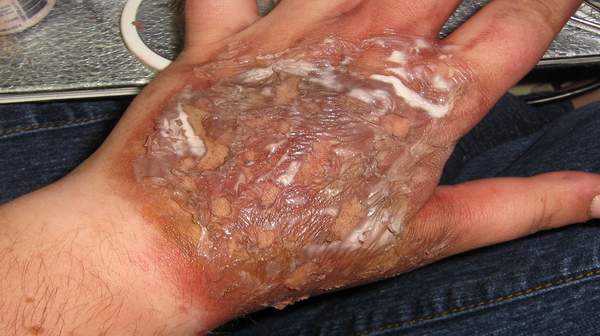What's in this article?
Chemical Burns Overview
A chemical burn is irritation and destruction of human tissue caused by exposure to a chemical, usually by direct contact with the chemical or its fumes. Chemical burns can occur in the home, at work or school, or as a result of accident or assault. Although few people in the United States die after contact with chemicals in the home, many substances common in both living and storage areas can do serious harm.
Many chemical burns occur accidentally through misuse of products such as those for hair, skin, and nail care. Although injuries do occur at home, the risk of sustaining a chemical burn is much greater in the workplace, especially in businesses and manufacturing plants that use large quantities of chemicals.
Most chemical burns are caused by either strong acids or strong bases (for example, hydrochloric acid or sodium hydroxide). Acids damage and kill cells by coagulating cells while bases liquefy cells. Prolonged exposure can severely damage human tissues and, if the patient survives, leads to scarring and disability. Other chemicals like oxidants and certain metals may also produce similar chemical burns. Limiting the time of exposure to any of these chemicals can greatly reduce their damaging effects.
If you have an immediately recognized chemical burn
- Remove the chemical causing the burn while protecting yourself. For dry chemicals, brush off any remaining material. Wear gloves or use a towel or other suitable object, such as a brush.
- Remove contaminated clothing or jewelry to prevent further burning.
- Rinse the burn immediately. Run a gentle, steady stream of cool tap water over the burn for 10 or more minutes. A shower may be an effective way to do this. Always protect your eyes.
- Loosely apply a bandage or gauze.
- If needed, take an over-the-counter pain reliever, such as ibuprofen (Advil, Motrin IB, others), naproxen sodium (Aleve) or acetaminophen (Tylenol, others).
- Consider a tetanus shot. Make sure that your tetanus booster is up to date. Doctors recommend people get a tetanus shot at least every 10 years.
If you have a possible Chemical Burn
- Make sure that any contaminated clothing or jewelry is no longer in contact with your skin.
- Rinse the burn if you think some of the chemical is still on your skin.
- Loosely apply a bandage or gauze.
- If needed, take an over-the-counter pain reliever, such as ibuprofen (Advil, Motrin IB, others), naproxen sodium (Aleve) or acetaminophen (Tylenol, others).
- Consider a tetanus shot. Make sure that your tetanus booster is up to date.
Symptoms of Chemical Burn
Depending on the type of exposure, the symptoms may include:
- Abdominal pain
- Breathing difficulty
- Bright red or bluish skin and lips
- Convulsions (seizures)
- Dizziness
- Eye pain, burning or watering
- Headache
- Hives, itching, swelling, or weakness resulting from an allergic reaction
- Irritability
- Nausea and/or vomiting
- Pain where the skin has come in contact with the toxic substance
- Rash, blisters, burns on the skin
- Unconsciousness or other states of altered level of consciousness
Chemical Burn Treatment
Most people with minor chemical burns do not need to be admitted. Most can go home after arranging follow-up care with a doctor. Patients with major chemical burns however, need to be admitted to a hospital. Ingestion or inhalation of chemical burns may need to be admitted for observation, depending on the potential severity of tissue damage.
First Aid for Chemical Burn
- Make sure the cause of the burn has been removed. Try not to come in contact with it yourself. If the chemical is dry, brush off any excess. Avoid brushing it into your eyes. Remove any contaminated clothing or jewelry.
- Flush the chemicals off the skin surface using cool running water for 15 minutes or more.
- Treat the person for shock if he or she appears faint, pale, or if there is shallow, rapid breathing.
- Apply cool, wet compresses to relieve pain.
- Wrap the burned area with a dry sterile dressing (if possible) or clean cloth. Protect the burned area from pressure and friction.
- Minor chemical burns will generally heal without further treatment. However, if there is a second or third degree burn or if there is an overall body reaction, get medical help right away. In severe cases, don’t leave the person alone and watch carefully for reactions affecting the entire body.
Note: If a chemical gets into the eyes, the eyes should be flushed with water right away. Continue to flush the eyes with running water for at least 15 minutes. Get medical help right away.







